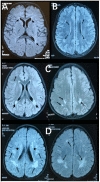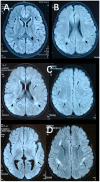Developmental Auditory and Speech-Language Performance in Pediatric Cochlear Implantation Recipients with Stable White Matter Lesions
- PMID: 38002500
- PMCID: PMC10669646
- DOI: 10.3390/brainsci13111540
Developmental Auditory and Speech-Language Performance in Pediatric Cochlear Implantation Recipients with Stable White Matter Lesions
Abstract
To analyze the association between stable asymptomatic white matter lesions (WMLs) and the cochlear implantation (CI) effect in congenitally deaf children, 43 CI children with stable asymptomatic WMLs determined via preoperative assessments and 86 peers with normal white matter were included. Outcome measurements included closed-set Mandarin Chinese (tone, disyllable, and sentence) recognition tests; categories of auditory performance (CAPs); and speech intelligibility rating (SIR) scales at 1, 12, and 24 months post-CI. Generalized estimating equation (GEE) models were used to analyze the association between WML and outcomes. In the WML group (control group), median CAP and SIR scores were 5 (5) and 4 (4) with mean rates of tone, disyllable, and sentence recognition of 84.8% (89.0%), 87.9% (89.7%), and 85.8% (88.0%) at 24 months post-CI, respectively. Auditory and speech performance improved significantly with implant use. Compared to their peers in the control group, for the participants with stable asymptomatic WMLs, auditory and speech abilities were not significantly different (p > 0.05). Stable asymptomatic WMLs might not be associated with poor auditory and speech intelligibility post-CI, which indicates that it is feasible to use comprehensive assessments to screen suitable candidates with WMLs who are likely to present with a good prognosis.
Keywords: CAP; SIR; cochlear implantation; pediatric; speech recognition; white matter lesions.
Conflict of interest statement
The authors declare no conflict of interest.
Figures





Similar articles
-
Cochlear implantation in prelingually deaf children with white matter lesions.Eur Arch Otorhinolaryngol. 2021 Feb;278(2):323-329. doi: 10.1007/s00405-020-06075-8. Epub 2020 May 28. Eur Arch Otorhinolaryngol. 2021. PMID: 32462235
-
Auditory performance and speech intelligibility of Mandarin-speaking children implanted before age 5.Int J Pediatr Otorhinolaryngol. 2014 May;78(5):799-803. doi: 10.1016/j.ijporl.2014.02.014. Epub 2014 Feb 20. Int J Pediatr Otorhinolaryngol. 2014. PMID: 24630030
-
Long-Term Auditory and Speech Outcomes of Cochlear Implantation in Children With Cochlear Nerve Aplasia.Ear Hear. 2023 May-Jun 01;44(3):558-565. doi: 10.1097/AUD.0000000000001299. Epub 2022 Dec 8. Ear Hear. 2023. PMID: 36476611 Free PMC article.
-
Auditory and Speech Outcomes of Cochlear Implantation in Children With Auditory Neuropathy Spectrum Disorder: A Systematic Review and Meta-Analysis.Ann Otol Rhinol Laryngol. 2023 Apr;132(4):371-380. doi: 10.1177/00034894221092201. Epub 2022 May 2. Ann Otol Rhinol Laryngol. 2023. PMID: 35499129
-
A Review of Speech Perception of Mandarin-Speaking Children With Cochlear Implantation.Front Neurosci. 2021 Dec 14;15:773694. doi: 10.3389/fnins.2021.773694. eCollection 2021. Front Neurosci. 2021. PMID: 34970113 Free PMC article. Review.
References
-
- Xu X.Q., Wu F.Y., Hu H., Su G.Y., Shen J. Incidence of Brain Abnormalities Detected on Preoperative Brain MR Imaging and Their Effect on the Outcome of Cochlear Implantation in Children with Sensorineural Hearing Loss. Int. J. Biomed. Imaging. 2015;2015:275786. doi: 10.1155/2015/275786. - DOI - PMC - PubMed
LinkOut - more resources
Full Text Sources
Miscellaneous

